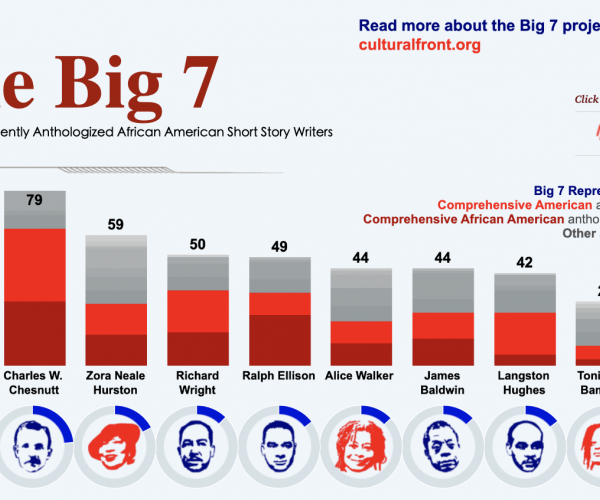
by Peace Ossom Williamson


by Peace Ossom Williamson
Read about the Big 7 project by Dr. Kenton Rambsy, Assistant Professor of African American Literature and Digital Humanities:
I conceived of the Big 7 after creating and performing a quantitative analysis of a dataset of over 100 anthologies’ metadata in order to identify the most frequently anthologized short story writers.
Standard literary histories, which emphasize key dates and moments, sometimes minimize subtle but important developing patterns, which take shape gradually. Biographical sketches, for instance, often note the 1937 publication date of Hurston’s novel Their Eyes Were Watching God or the fact that her life and career received renewed notice during the 1970s after Alice Walker wrote about her. However, it was not until the 1990s that Hurston’s short stories began regularly appearing in anthologies. There is hardly any acknowledgment of the important roles editors played within the last 30 years of elevating Hurston the short story writer in canonical history.
A dataset on anthologies clarifies the extended amount of time and the large number of editors contributing to the publication of black writers, and even to an individual story, and a clear trend emerged.
Over the course of 90 years, and particularly the last 40 years, anthology editors shaped the landscape of African American literature by repeatedly publishing approximately 30 stories by a core group of writers: Charles Chesnutt, Zora Neale Hurston, Richard Wright, Ralph Ellison, James Baldwin, Toni Cade Bambara, and Alice Walker. Editors essentially established a “Big 7” of African American short fiction writers.
Those 7 writers collectively wrote 75 of the 639 unique short stories published in 100 anthologies published between 1925 and 2017. Professors who teach literature surveys often utilize one comprehensive anthology in a course not many. Yet, contemporary anthologies were based on a profusion of a previous collection. Because a variety of constraints limit what editors can republish, short stories became central to the history of anthologies, although novels received more critical and popular acclaim. Consequently, the habitual selection of short fiction for inclusion in anthologies became one crucial way that editors participated in canon formation.
Drawing on the dataset, I worked with UTA Libraries' Peace Ossom-Williamson to create a Tableau Public dashboard that highlights the significance of the Big 7, Langton Hughes, and other writers whose have at least four stories republished in anthologies. The one-page visualization highlights the various contexts for the most frequently anthologized black writers and stories published in collections between 1925 and 2017. The visualization seeks to illuminate selected fields in the dataset thereby making a large body of information more manageable.
African American publishing histories are multifaceted, and conventional bibliographies offer only so much information. Thus, we should embrace the use of datasets in order to enhance our understanding of black cultural productions. A dataset on the thousands of items associated with the transmission of African American short stories, for instance, moves us closer to uncovering the details behind vague phrases like “frequently anthologized” and “widely anthologized.” In addition, accumulated and organized data on African American literary art lends itself to a variety of useful, informative visualizations. Our abilities to effectively share ideas about African American publishing histories ultimately depend on how well we see it.
Dashboard Creator: Kenton Rambsy & Peace Ossom-Williamson. Copyright: Creative Commons Attribution 4.0 International (CC BY 4.0)
Attend the Tableau Data Prep workshop on Feb 27 at 1:30 PM.
Download and reuse the data from the growing Black Studies & Digital Humanities Dataverse.
Add new comment